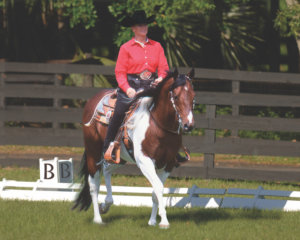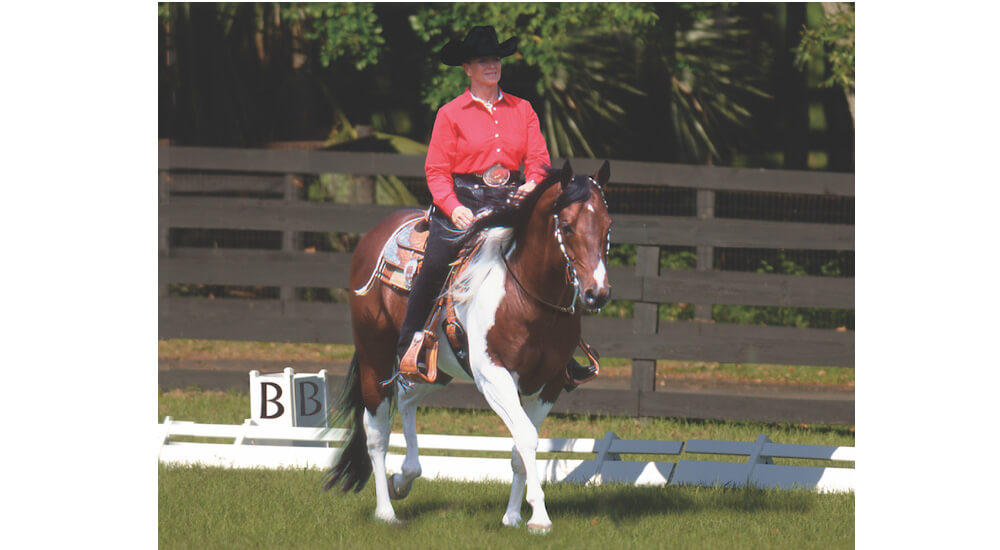Establish Good Communication through Aids
By Lynn Palm

It’s essential that horses are balanced to maximize athleticism. Balance can only be attained when your horse is driving himself forward from his hindquarters with his body straight. To get your horse to go forward you must have good communication with him through your aids. The three aids we’ll discuss are your reins, legs, and seat.
Aid 1: Reins
Your hands “talk” through the reins to the front third of your horse’s body, withers to poll. Think of this area as his steering wheel. To keep your horse light and willing, your hands/reins should comprise no more than 20 percent of your aids.
We’ll focus on two types of rein aids here—an opening (leading) rein and an indirect (neck) rein.
Opening (Leading) Rein
Rein contact directly out to the side leads your horse’s nose in the chosen direction.
To apply the aid, establish light contact with both reins. Bring your right hand directly out to the side until you can see the corner of your horse’s right eye. (If you can see more of his eye then you have pulled his head too far and his body is out of alignment.) Tip your thumb to the right as though you are turning a key in a lock. This prevents you from pulling back which would impede his forward movement and balance.
Indirect (Neck) Rein
A neck rein is not an aid, but rather a cue. A rein laid against the left side of your horse’s neck tells him to go right. It’s a conditioned response. Through repetition, your horse learns that rein pressure against his neck will be accompanied by bit pressure from the opposite rein. He soon learns to turn in response to the rein pressure alone.
To apply a left neck rein for a turn to the right, tip your left thumb slightly outward as you lay that rein against the left side of your horse’s neck. Keep your right hand neutral while maintaining the same distance between both hands. Avoid the temptation to cross your horse’s withers with your cue hand because doing so would pull his head to the left (opposite of where you want it to be) which would ruin his alignment.
Aid 2: Legs
Your legs influence the back two-thirds of your horse’s body, from the withers to the tail. Think of this as his engine. Your legs (combined with your seat) will act as both accelerator and brakes. Decreased pressure means “stop”; increased pressure means “go”. Together they should comprise 80 percent of your aids.
Aid 3: Seat
Your seat controls your horse’s hind legs and, thus, his speed. When you are correctly balanced, your hips move in sync with your horse’s motion.
To speed him up, move your hips faster than his current movement by pushing them forward in the saddle as though propelling a swing higher. To slow down, tighten your stomach and rump muscles in order to slow your hips’ following motion.
Support your seat aid with light rein aids, and you’ll keep your horse’s weight rocked back over his hindquarters so that he slows but retains the energy needed to balance.
Now we will put these aids to use in an exercise.
Body Control on a Circle
Warm up your horse. When he’s relaxed and focused, use your leg and seat aids to pick up a forward jog. Use the following aids to guide your horse onto a circle to the right:
- Right leg just behind the cinch, or at a spot where he’s responsive (my horse’s responsive spot is farther back, so that’s where my leg is). Light leg pressure here will arc his body on the circle’s track and prevent him from leaning to the inside.
- Inside (right) opening rein, to bend his head and neck slightly to the inside.
- Light left leg pressure about six inches or so behind the cinch to slightly tip his hip to the inside.
- Outside (left) indirect rein to block his shoulders from bulging to the outside and to prevent his head from tipping too far to the inside.
As you do this exercise, keep your head up and your eyes looking ahead on your track. This will help subliminally to guide your horse on the circle. Stay balanced and centered in the saddle with your shoulders mirroring his. If you tip or slouch in one direction or the other, your horse will be forced to change his alignment to balance beneath you, which is counter to our goal. Be sure your contact is light so that your horse feels free to move forward.
If you have trouble keeping your circles round, mark out your circle with a series of double cones spaced far enough apart so that your horse can travel between the two. Besides helping to keep your circles round, the cones will make it easier to spot if your horse falls in or out.

The Northwest Horse Source is an independently owned and operated print and online magazine for horse owners and enthusiasts of all breeds and disciplines in the Pacific Northwest. Our contemporary editorial columns are predominantly written by experts in the region, covering the care, training, keeping and enjoyment of horses, with an eye to the specific concerns in our region.






